When the arcade game Donkey Kong was released in 1981, it would have been impossible to predict the playable character, then known to American gamers as Jumpman, would go on to become the most famous and recognizable video game character of all time. Since his inception 36 years ago, Mario has branched out into his own series that has sold more than 210 million units worldwide.
Similarly, when the original Grand Theft Auto was released in 1997 as a top-down, open-world action game, no one could have predicted that 16 years later Grand Theft Auto V would break six Guinness World Records for entertainment sales, including the fastest entertainment property (that includes films and album releases) to gross $1 billion, a feat it achieved in just three days.
Video games have a way of over-performing and venturing into territory no one expected. The most recent example of this is seen in the meteoric rise of professional or competitive gaming, otherwise known as eSports, over the last decade. These live and virtual events pit the best gamers in the world against each other in popular games such as Dota 2, League of Legends, Counter Strike, and Call of Duty.
The frequency and scale of eSports competitions are gaining on traditional sporting events. The International 2017, a Dota 2 competitive gaming event, drew an audience of five million concurrent viewers and had a total purse of $24.6 million, including a $10.8 million prize for the winning team (Team Liquid of Utrecht, Netherlands). Gone are the halcyon days of initialed high scores on an arcade cabinet screen.
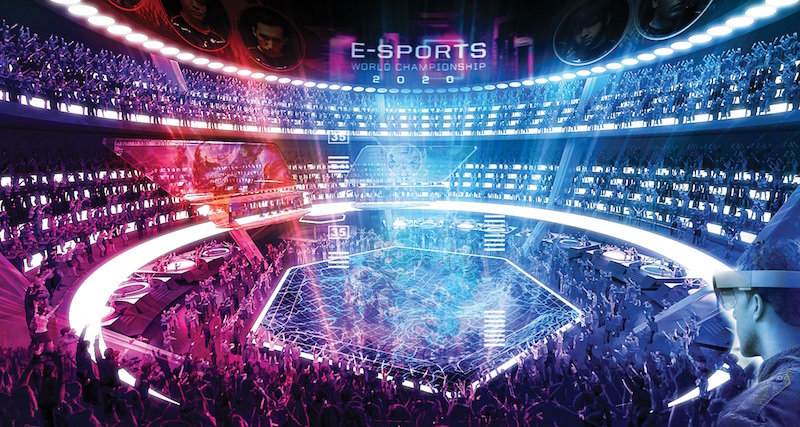 A holographic stage feature will help support and simplify the gameplay for the audience by providing a clean way to view complex peripheries, such as map information. Rendering courtesy Populous.
A holographic stage feature will help support and simplify the gameplay for the audience by providing a clean way to view complex peripheries, such as map information. Rendering courtesy Populous.
Billion-dollar market by 2020
According to the 2017 Global eSports Market Report, eSports revenue is expected to reach $696 million in 2017, a 41% rise over the 2016 figures. By 2020, that number will nearly double, to $1.3 billion, says the report’s author, eSports market research firm Newzoo.
The group puts the global eSports audience at 385 million, split evenly between “enthusiasts” and “occasional viewers.” The average direct spending per eSports fan on merchandise, tickets, and subscriptions was $0.33 in 2017. Compared to traditional sports, this is very low (basketball, for example, generates $15/fan worldwide). The problem, says Newzoo, is the fact that eSports content is still largely available for free, and the money spent on merchandise remains relatively small.
In order for fan spending to increase, fans need a reason to plunk down hard-earned cash on something they can easily stream at home for free. This means creating an environment that fans cannot easily replicate within the comfort of their own home.
There are a few dedicated eSports arenas stippled around the country—eSports Arena in Santa Ana, Calif., and Blizzard Arena LA in Los Angeles are the most prominent—but these venues barely scratch the surface of what an eSports arena can, and should, be.
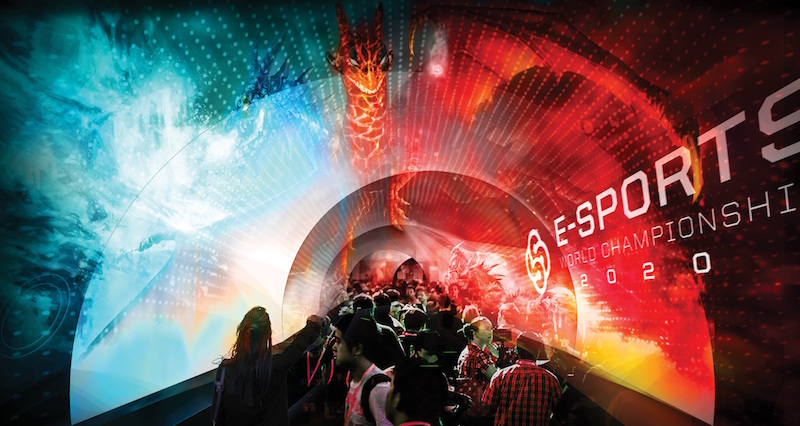 From the moment fans enter the arena (below) they will be immersed in the spectacle of the event by a smorgasbord of technology. Rendering courtesy Populous.
From the moment fans enter the arena (below) they will be immersed in the spectacle of the event by a smorgasbord of technology. Rendering courtesy Populous.
“There isn’t, at this stage, what I would classify as a traditional arena that has been dedicated to eSports,” says Brian Mirakian, Senior Principal with Populous and Director of the firm’s fan experience design practice, Populous Activate. “We think that is going to happen in the pretty near future. I see it within the next three to five years, maybe sooner.”
In 2017, the Intel Extreme Masters event, held in Katowice, Poland, drew a record 173,000 fans to the multipurpose Spodek Arena. In addition to the fans that attended the event and accompanying festival, another 46 million unique viewers watched online from around the world. In order to lure some of those streamers out of their homes and to the actual eSports events, more dedicated, purpose-built spaces are needed.
These second-generation eSports arenas need to provide an experience fans can’t get at home. Jumbotrons, assigned seating, and $7 hotdogs aren’t going to cut it with this crowd.
See Also: One Transformable Ceiling, three fan experiences
Anatomy of an eSports arena
Determining what the eSports fan wants in an eSports arena experience is difficult, simply because their desires differ from that of fans of traditional sports.
“A lot of fans actually prefer to sit back from the stage, which runs contrary to other sports where you want to be as close to the action as possible,” says Mirakian, a BD+C 40 Under 40 Class of 2015 honoree. The action during an eSports event occurs on screen, so sitting farther away provides a better view. The seats themselves will have the ability to tilt back to allow for more optimized viewing of screens that are above the competition stage.
There’s a catch, though. Even with these optimized, reclining seats, the eSports fan doesn’t want to spend their entire time sitting in one spot watching a screen—they can do that at home, for free. These eSports arenas need to provide something the average eSports fan can’t get at home: a full-on social experience, says Ryan Gedney, Vice President and Senior Project Designer with HOK’s Sports + Recreation + Entertainment practice.
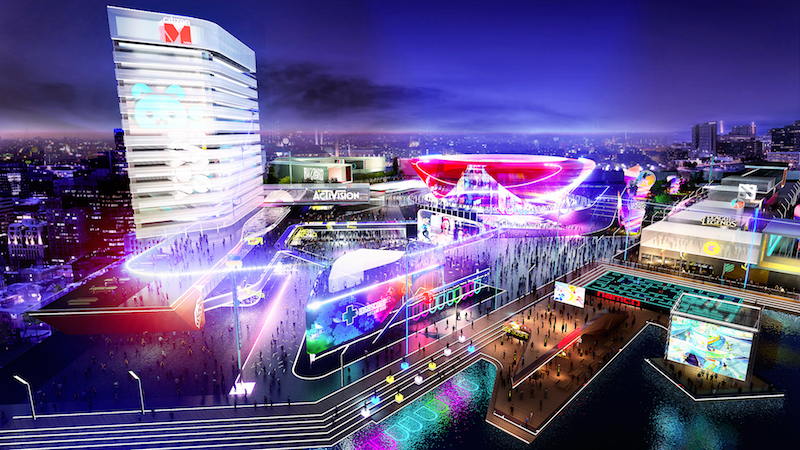 Different publishers (Activision, Nintendo) could have bespoke areas with themed food, beverage, entertainment, and souvenir offerings. Rendering courtesy Populous.
Different publishers (Activision, Nintendo) could have bespoke areas with themed food, beverage, entertainment, and souvenir offerings. Rendering courtesy Populous.
Gedney describes popular eSports events as more akin to music festivals rather than traditional concerts or sporting events. “They are trying to leverage multiple spaces, multiple competition scales, all at one time,” says Gedney, a BD+C 40 Under 40 Class of 2016 honoree. “There might be a main event in the primary seating bowl, but the plazas and lobby spaces are all working in concert together.”
Mirakian agrees. “There is a real opportunity for more social spaces, where fans can freely migrate to different zones throughout the venue, gather with like-fans and friends, and just watch from a standing position,” he says. “It’s a very different approach to how we have designed traditional seating bowls.”
It is this highly social, free-roaming, festival-like approach that designers believe will help draw more fans out of their homes to attend live eSports events. In order for this to work, however, fans need a deep sense of connection with the action on stage wherever they are within the venue. They also need a reason to move to other places in that venue.
Most eSports fans are young and affluent and have very different consumer spending patterns than generations before them. Energy drinks replace alcohol and typical stadium victuals—burgers, dogs, brats, pizza, pretzels—are swapped for healthier, localized options. The concourse is no longer just a connection point between fans’ seats and food and drink options—it becomes a crucial link to the gaming action and a hub where fans and friends can meet and socialize.
“We’re talking about a completely different event experience,” says Mirakian.
A dedicated eSports arena becomes its own mini entertainment district. General admission passes replace assigned seating, allowing fans to come and go as they please and roam the various spaces during events.
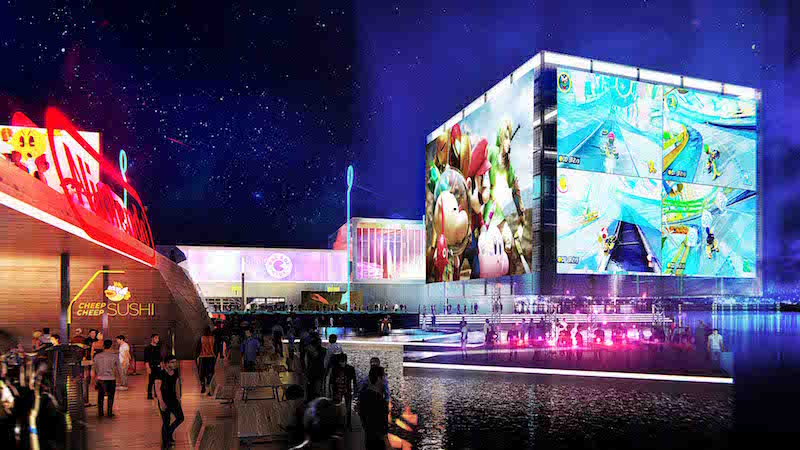 No matter where a fan may roam, they will always be connected to the action via strategically placed displays. Rendering courtesy Populous.
No matter where a fan may roam, they will always be connected to the action via strategically placed displays. Rendering courtesy Populous.
Design eSports arenas with the future in mind
Naturally, the most important aspect of a dedicated eSports arena is the way in which technology is integrated, both from a fan perspective and a competitor perspective.
“The embellished drama of the event is through technology,” says Gedney. “How best do we celebrate this gladiatorial sport when, ultimately, the conflict is through 1s and 0s on a display? It is very much centered around technology.” Large-format HD displays, augmented reality, and virtual reality are all going to play an important role in the eSports arena of the future, says Gedney.
Populous is exploring the idea of a centralized stage feature that would allow for holographic information to be projected onto it, or for use with augmented reality. Many of the games that are popular in the competitive world, such as Dota 2 and League of Legends, involve complex action and strategy taking place on peripheral maps. Augmented reality and a holographic display would simplify this action for fans and allow them to follow along more closely with integrated displays that surround the center feature.
Gedney sees the future of augmented reality at eSports arenas reaching an even higher level of integration, possibly even eliminating the need for physical signage and wayfinding. In order for this to work, these stadiums are going to need to provide the Bluetooth and WiFi capabilities to support crowds of anywhere from 3,000 to 10,000 people, all wearing AR glasses.
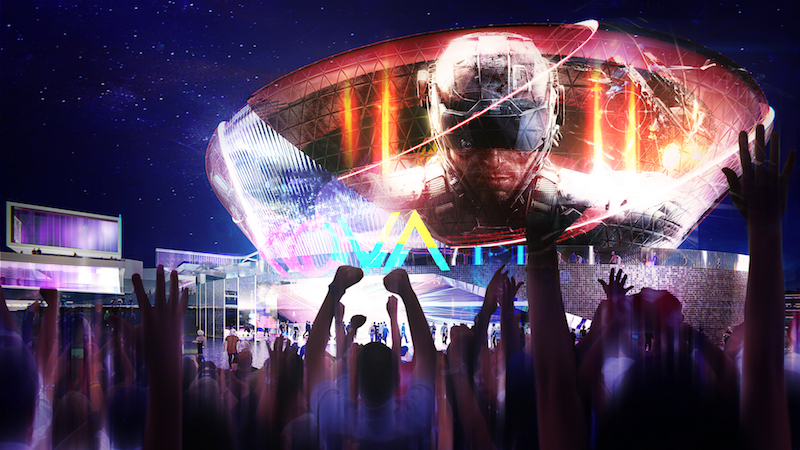 A dedicated eSports arena could become more akin to a theme park and a music festival rolled into one. Rendering courtesy Populous.
A dedicated eSports arena could become more akin to a theme park and a music festival rolled into one. Rendering courtesy Populous.
Virtual reality experiences in various locations throughout a venue would give fans the ultimate front-row seat by placing them directly in the middle of battles. VR stations at the Intel Extreme Masters event in Poland gave fans a 360-degree experience to view live stats, replays, and scores updated in real-time.
With the importance of and reliance on technology in eSports stadiums arises another problem: future-proofing. New technology is not atemporal, so how do AEC teams make sure these venues can evolve with the times and be easily updated and outfitted with the newest technology after it has been constructed?
See Also: With a new type of stadium comes a new type of premium seat
The key is to create a technological backbone, or chassis, to which the ever-evolving technology can be affixed, says Mirakian. “If you have a big enough technology pipeline where you can plug things in from a framework standpoint, that’s the important thing,” he says.
“Scaled up” is an apt term to apply to a dedicated eSports arena on all fronts: the technology, amenity offerings, and fan experience can reach heights that would be onerous with events held in multipurpose spaces. It becomes clear that the rising popularity of eSports and the desires of its fans lead inexorably to an incoming wave of dedicated eSports arenas.
“The purpose-built venue is going to be a big component that drives eSports,” says Mirakian. “Looking into the future is very exciting.”
eSports Market at a Glance
Revenue: $696 million worldwide (2017); $1.3 billion (F2020)
Audience: 385.5 million worldwide (2017); 589 million (F2020)
No. of events: 424 worldwide (2016)
Total ticket revenue: $32 million (2016), up 52% from previous year
Total prize money: $93 million (2016), also up 52% from previous year
Popular locations: North America (28%), Western Europe (26%), Eastern Europe (13%)
Audience breakdown: 71% male; 79% under 35 years old; 44% “high household income”
Related Stories
Retail Centers | Jun 2, 2023
David Adjaye-designed mass timber structure will be a business incubator for D.C.-area entrepreneurs
Construction was recently completed on The Retail Village at Sycamore & Oak, a 22,000-sf building that will serve as a business incubator for entrepreneurs, including emerging black businesses, in Washington, D.C. The facility, designed by Sir David Adjaye, the architect of the National Museum of African American History and Culture, is expected to attract retail and food concepts that originated in the community.
Mass Timber | May 23, 2023
Luxury farm resort uses CLT framing and geothermal system to boost sustainability
Construction was recently completed on a 325-acre luxury farm resort in Franklin, Tenn., that is dedicated to agricultural innovation and sustainable, productive land use. With sustainability a key goal, The Inn and Spa at Southall was built with cross-laminated and heavy timber, and a geothermal variant refrigerant flow (VRF) heating and cooling system.
Hotel Facilities | May 9, 2023
A new camping destination near Utah’s Zion National Park offers a variety of all-season lodgings and amenities
Outdoor lodging brand AutoCamp has opened a new camping destination near Utah’s Zion National Park. A 16-acre property, AutoCamp Zion is located between the Virgin River and the desert of Southern Utah.
Digital Twin | May 8, 2023
What AEC professionals should know about digital twins
A growing number of AEC firms and building owners are finding value in implementing digital twins to unify design, construction, and operational data.
Green | Apr 21, 2023
Top 10 green building projects for 2023
The Harvard University Science and Engineering Complex in Boston and the Westwood Hills Nature Center in St. Louis are among the AIA COTE Top Ten Awards honorees for 2023.
Sports and Recreational Facilities | Mar 15, 2023
Georgia State University Convocation Center revitalizes long-neglected Atlanta neighborhood
Georgia State University’s new Convocation Center doubles the arena it replaces and is expected to give a shot in the arm to a long-neglected Atlanta neighborhood. The new 200,000 sf multi-use venue in the Summerhill area of Atlanta is the new home for the university’s men’s and women’s basketball teams and will also be used for large-scale academic and community events.
Sports and Recreational Facilities | Feb 27, 2023
New 20,000-seat soccer stadium will anchor neighborhood development in Indianapolis
A new 20,000-seat soccer stadium for United Soccer League’s Indy Eleven will be the centerpiece of a major neighborhood development in Indianapolis. The development will transform the southwest quadrant of downtown Indianapolis by adding more than 600 apartments, 205,000 sf of office space, 197,000 sf for retail space and restaurants, parking garages, a hotel, and public plazas with green space.
Museums | Feb 17, 2023
First Americans Museum uses design metaphors of natural elements to honor native worldview
First Americans Museum (FAM) in Oklahoma City honors the 39 tribes in Oklahoma today, reflecting their history through design metaphors of nature’s elements of earth, wind, water, and fire. The design concept includes multiple circles suggested by arcs, reflecting the native tradition of a circular worldview that encompasses the cycle of life, the seasons, and the rotation of the earth.
Giants 400 | Feb 9, 2023
New Giants 400 download: Get the complete at-a-glance 2022 Giants 400 rankings in Excel
See how your architecture, engineering, or construction firm stacks up against the nation's AEC Giants. For more than 45 years, the editors of Building Design+Construction have surveyed the largest AEC firms in the U.S./Canada to create the annual Giants 400 report. This year, a record 519 firms participated in the Giants 400 report. The final report includes 137 rankings across 25 building sectors and specialty categories.
Steel Buildings | Feb 3, 2023
Top 10 structural steel building projects for 2023
A Mies van der Rohe-designed art and architecture school at Indiana University and Morphosis Architects' Orange County Museum of Art in Costa Mesa, Calif., are among 10 projects to win IDEAS² Awards from the American Institute of Steel Construction.

















